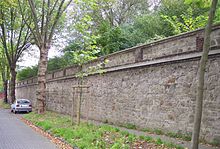Scharnhorst colliery
| Scharnhorst colliery | |||
|---|---|---|---|
| General information about the mine | |||
|
The Scharnhorst colliery in the 1970s |
|||
| Funding / year | approx. 500,000 t | ||
| Information about the mining company | |||
| Employees | circa 1800 | ||
| Start of operation | 1901 | ||
| End of operation | 1931 | ||
| Successor use | Commercial space | ||
| Funded raw materials | |||
| Degradation of | Hard coal | ||
| Geographical location | |||
| Coordinates | 51 ° 32 '27 " N , 7 ° 31' 18" E | ||
|
|||
| Location | Alt-Scharnhorst | ||
| local community | Dortmund | ||
| Independent city ( NUTS3 ) | Dortmund | ||
| country | State of North Rhine-Westphalia | ||
| Country | Germany | ||
| District | Ruhr area | ||
The Scharnhorst colliery was a coal - mine in named after her Dortmunder district Alt-Scharnhorst .
history
In 1871 the mining law union of the Scharnhorst coal mine , named after the Prussian general and army reformer Gerhard von Scharnhorst , was founded. In 1872 work began on sinking the first shaft . However, the work had to be stopped two years later due to severe water ingress.
After the mine together with the adjacent mines in 1891 Gneisenau Colliery and mine Prussia from the Harpen Mining AG was taken over, you put the Abteufarbeiten continued 1897/1898. Production finally began in August 1901. In 1908 the colliery reached its maximum output of 517,200 tons with around 1,820 employees. A coking plant was operated from 1902 to 1927.
After 1930 an underground connection to the third floor to Gneisenau Colliery had been prepared, which provided Scharnhorst colliery on 1 February 1931, the promotion of one. However , it remained in operation until July 31, 1975 for cable travel , ventilation and material transport .
present
On the former colliery site there is now a (not yet fully developed) industrial area, located on the street Scharnhorst colliery
Almost nothing is left of the representative, symmetrically laid out and uniformly designed mine, the only sparse relic is a colliery wall that has now been restored . In the area, however, the associated colliery settlements are still partially preserved. The pulley of a Tomson trestles built headframes graces today as a symbol of the coat of arms of the district Scharnhorst.
The colliery is registered as a ground monument in the monument list of the city of Dortmund .
See also
literature
- Wilhelm Hermann, Gertrude Hermann: The old mines on the Ruhr. 6th edition, updated by Christiane Syré and Hans-Curt Köster. Langewiesche, Königstein im Taunus 2007, ISBN 3-7845-6994-3 .
Web links
Individual evidence
- ↑ No. B 0023. List of monuments of the city of Dortmund. (PDF) (No longer available online.) In: dortmund.de - Das Dortmunder Stadtportal. Monument Authority of the City of Dortmund, April 14, 2014, archived from the original on September 15, 2014 ; accessed on April 15, 2014 (size: 180 kB). Info: The archive link was inserted automatically and has not yet been checked. Please check the original and archive link according to the instructions and then remove this notice.



